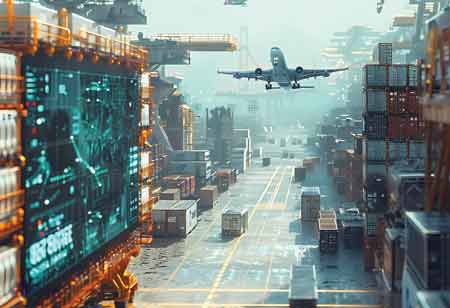The transport and logistics industry stands at a crossroads. With global emissions targets quickly moving from distant goals to looming deadlines, the pace of decarbonization is accelerating—along with the urgency to reconsider our traditional ways of doing business. As a sector contributing significantly to global greenhouse gas emissions, the sense of urgency is undeniable. The time to act is now.
A Clear Roadmap for Decarbonization That Requires Scalability
At DSV, we’ve developed a robust decarbonization roadmap aligned with our 2030 Science-Based Targets. The insights shared in this editorial are based on our firsthand experience deploying this plan, which has provided valuable lessons on the opportunities and challenges of large-scale decarbonization efforts. Central to our roadmap is the deployment of low- and zero-emission vehicles:
●
2024-2026: Deploying 300 low- and zero-emission vehicles.
●
By 2030: Rolling out 2,000 Battery Electric Trucks across our fleet.
To ensure we meet these ambitious targets, we’ve translated our overarching goals into actionable Key Performance Indicators (KPIs) for each country and region within DSV’s Road division. This granular approach ensures accountability and steady progress across our operations.
Where Are We Today as an Industry?
Decarbonizing road transport is no easy task, particularly given the complexities of scaling sustainable solutions. Here is where we currently stand as an industry:
●
Maturity of Decarbonization Levers: Unlike other transport modes, road transport has several decarbonization levers that can be deployed today. While some levers still need to mature—such as hydrogen trucks and e-trailers—we already have viable solutions like Battery Electric Vehicles (BEVs), increased load factors, and replacing old trucks with newer, less polluting models. However, transitioning to low- and zero-emission vehicles isn’t a simple one-to-one asset replacement. It often requires changes to operating models, lead times, and other logistical considerations. Additionally, adopting BEVs and building the necessary charging infrastructure demands a significant investment. Without customer support, the financial burden often falls on haulers or freight forwarders, limiting uptake and scalability.
We are currently using the first generation of BEVs, which, while groundbreaking, come with high costs and a limited range of approximately 250 kilometers. However, technological advancements are progressing rapidly, and we expect second-generation trucks with ranges of 400 to 670 kilometers at more affordable price points shortly. This will be a significant step forward in capability and cost efficiency, opening the door to broader adoption.
The journey to decarbonize road transport is urgent and achievable. By leveraging innovation, fostering partnerships, and embracing change, we can lead the way toward a sustainable future for both our industry and the planet
●
Financial Models: To scale decarbonization efforts, innovative financial mechanisms, such as book-and-claim systems, are needed to support investments in sustainable solutions. The industry requires commercial mechanisms that facilitate the deployment of BEVs, enabling large-scale solutions rather than limiting them to operations where customers are willing to pay and adjust their processes. For this to happen, these mechanisms must be approved by relevant institutions like the Science-Based Targets initiative.
●
Infrastructure and Renewable Energy: A pressing concern is whether grid capacity and renewable energy sources will keep pace with technological advancements. Both must accelerate to support vehicle innovation and ensure a sustainable transition. Scaling up will require a robust infrastructure, including widespread charging and refueling networks, and reliable access to renewable energy. At DSV, we are ramping up solar panel installations at our facilities to enable daytime charging for BEVs and ensure overnight access to charging stations for both haulers and our trucks. However, charging at home depots alone will not be enough to scale operations. Access to infrastructure “on the go” and at customer facilities is critical.
●
Onboarding People: The human element of this transformation cannot be overlooked. If new, transformative solutions aren’t properly communicated and implemented, people may try to fit them into existing business models, which will only slow the decarbonization process. Change management is therefore essential, requiring leadership to guide organizations through this complex transition.
What Is Needed to Scale Decarbonization?
●
Transforming a People Business: The transport and logistics industry is a people-driven business fundamentally, and large-scale transformation takes time. Effective management of this change demands strong leadership and the capability to simplify new solutions for easy understanding and implementation. We must balance the deployment of new assets with a “learning by doing” approach, simplifying their adoption so business partners and colleagues can embrace and scale these solutions.
●
Partnership Is the New Leadership: The speed and effectiveness of decarbonization will depend on collaboration across industries and sectors. While the solutions exist, their implementation hinges on how quickly we adapt our business practices to the new normal and how fast we establish the enabling framework conditions. For example, DSV’s recent partnership with Volvo Trucks to deploy 300 BEVs by 2026 is an excellent demonstration of cross-industry collaboration to accelerate decarbonization.
The journey to decarbonize road transport is both urgent and achievable. By leveraging innovation, fostering partnerships, and embracing change, we can lead toward a sustainable future for our industry and the planet. As we enter 2025, we find ourselves in a critical window of opportunity. With only 48 to 60 months remaining to make scalable transformation a reality, the time for decisive action and innovative collaboration is now.


